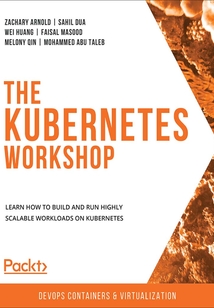舉報(bào) 

會(huì)員
The Kubernetes Workshop
最新章節(jié):
Summary
Thankstoitsextensivesupportformanaginghundredsofcontainersthatruncloud-nativeapplications,Kubernetesisthemostpopularopensourcecontainerorchestrationplatformthatmakesclustermanagementeasy.ThisworkshopadoptsapracticalapproachtogetyouacquaintedwiththeKubernetesenvironmentanditsapplications.StartingwithanintroductiontothefundamentalsofKubernetes,you’llinstallandsetupyourKubernetesenvironment.You’llunderstandhowtowriteYAMLfilesanddeployyourfirstsimplewebapplicationcontainerusingPod.You’llthenassignhuman-friendlynamestoPods,explorevariousKubernetesentitiesandfunctions,anddiscoverwhentousethem.Asyouworkthroughthechapters,thisKubernetesbookwillshowyouhowyoucanmakefull-scaleuseofKubernetesbyapplyingavarietyoftechniquesfordesigningcomponentsanddeployingclusters.You’llalsogettogripswithsecuritypoliciesforlimitingaccesstocertainfunctionsinsidethecluster.Towardtheendofthebook,you’llgetarundownofKubernetesadvancedfeaturesforbuildingyourowncontrollerandupgradingtoaKubernetesclusterwithoutdowntime.Bytheendofthisworkshop,you’llbeabletomanagecontainersandruncloud-basedapplicationsefficientlyusingKubernetes.
目錄(139章)
倒序
- 封面
- 版權(quán)信息
- Preface
- 1. Introduction to Kubernetes and Containers
- Introduction
- The Evolution of Software Development
- Virtual Machines versus Containers
- Docker Basics
- The Essence of Linux Container Technology
- The Need for Container Orchestration
- Welcome to the Kubernetes World
- Summary
- 2. An Overview of Kubernetes
- Introduction
- Setting up Kubernetes
- Kubernetes Components Overview
- Kubernetes Architecture
- Migrating Containerized Application to Kubernetes
- Delivering Kubernetes-Native Applications
- Pod Life Cycle and Kubernetes Components
- Summary
- 3. kubectl – Kubernetes Command Center
- Introduction
- How kubectl Communicates with Kubernetes
- Setting up Environments with Autocompletion and Shortcuts
- Common kubectl Commands
- Populating Deployments in Kubernetes
- Summary
- 4. How to Communicate with Kubernetes (API Server)
- Introduction
- The Kubernetes API Server
- Kubernetes HTTP Request Flow
- The Kubernetes API
- Scope of API Resources
- API Groups
- API Versions
- Interacting with Clusters Using the Kubernetes API
- Direct Access to the Kubernetes API Using Authentication Credentials
- Summary
- 5. Pods
- Introduction
- Pod Configuration
- Life Cycle of a Pod
- Probes/Health Checks
- Summary
- 6. Labels and Annotations
- Introduction
- Labels
- Annotations
- Summary
- 7. Kubernetes Controllers
- Introduction
- ReplicaSets
- Deployment
- StatefulSets
- DaemonSets
- Jobs
- Summary
- 8. Service Discovery
- Introduction
- Service
- Ingress
- Summary
- 9. Storing and Reading Data on Disk
- Introduction
- Volumes
- Persistent Volumes
- Dynamic Provisioning
- Summary
- 10. ConfigMaps and Secrets
- Introduction
- What Is a ConfigMap?
- What Is a Secret?
- Summary
- 11. Build Your Own HA Cluster
- Introduction
- How the Components of Kubernetes Work Together to Achieve High Availability
- Building a High-Availability Focused Kubernetes Cluster
- Summary
- 12. Your Application and HA
- Introduction
- An Overview of Infrastructure Life Cycle Management
- Terraform
- Kubernetes Ingress
- Highly Available Applications Running on Top of Kubernetes
- Working with Stateful Applications
- Summary
- 13. Runtime and Network Security in Kubernetes
- Introduction
- Threat Modeling
- Cluster Security
- Kubernetes RBAC
- NetworkPolicies
- PodSecurityPolicy
- Summary
- 14. Running Stateful Components in Kubernetes
- Introduction
- Stateful Apps
- Understanding StatefulSets
- Further Refactoring Our Application
- Helm
- Summary
- 15. Monitoring and Autoscaling in Kubernetes
- Introduction
- Kubernetes Monitoring
- Autoscaling in Kubernetes
- Summary
- 16. Kubernetes Admission Controllers
- Introduction
- How Admission Controllers Work
- Creating Controllers with Custom Logic
- How a Webhook Works
- Validating a Webhook
- Summary
- 17. Advanced Scheduling in Kubernetes
- Introduction
- The Kubernetes Scheduler
- The Pod Scheduling Process
- Managing the Kubernetes Scheduler
- Pod Affinity and Anti-Affinity
- Pod Priority
- Taints and Tolerations
- Using a Custom Kubernetes Scheduler
- Summary
- 18. Upgrading Your Cluster without Downtime
- Introduction
- The Need to Upgrade Your Kubernetes Cluster
- Kubernetes Components – Refresher
- The Upgrade Process
- Upgrading Kubernetes Master Components
- Upgrading Kubernetes Worker Nodes
- Summary
- 19. Custom Resource Definitions in Kubernetes
- Introduction
- What Is a Custom Controller?
- Standard Kubernetes API Resources
- Why We Need Custom Resources?
- How Our Custom Resources Are Defined
- Summary 更新時(shí)間:2021-06-11 18:18:31
推薦閱讀
- 連接未來(lái):從古登堡到谷歌的網(wǎng)絡(luò)革命
- Building E-commerce Sites with VirtueMart Cookbook
- Hands-On Chatbot Development with Alexa Skills and Amazon Lex
- NB-IoT物聯(lián)網(wǎng)技術(shù)解析與案例詳解
- 5G技術(shù)與標(biāo)準(zhǔn)
- Qt5 Python GUI Programming Cookbook
- 精通SEO:100%網(wǎng)站流量提升密碼
- 智能物聯(lián)安防視頻技術(shù)基礎(chǔ)與應(yīng)用
- OSPF協(xié)議原理與功能拓展
- 互聯(lián)網(wǎng)戰(zhàn)略變革與未來(lái)
- 物聯(lián)網(wǎng)概論
- 結(jié)網(wǎng)@改變世界的互聯(lián)網(wǎng)產(chǎn)品經(jīng)理(修訂版)
- Scala Programming Projects
- Oracle ADF Faces Cookbook
- 一本書(shū)讀懂24種互聯(lián)網(wǎng)思維
- Full-Stack Web Development with Vue.js and Node
- Internet應(yīng)用技術(shù)立體化教程
- 5G與車(chē)聯(lián)網(wǎng):基于移動(dòng)通信的車(chē)聯(lián)網(wǎng)技術(shù)與智能網(wǎng)聯(lián)汽車(chē)
- Advanced Penetration Testing for Highly-Secured Environments:The Ultimate Security Guide
- 工業(yè)互聯(lián)網(wǎng)創(chuàng)新實(shí)戰(zhàn):技術(shù)、產(chǎn)業(yè)融合、案例分析全案
- VMware vSphere企業(yè)運(yùn)維實(shí)戰(zhàn)
- 物聯(lián)網(wǎng)之芯:傳感器件與通信芯片設(shè)計(jì)
- Full-Stack React Projects
- 鏈接與分享:中國(guó)互聯(lián)網(wǎng)站分類(lèi)研究
- 5G安全:數(shù)智化時(shí)代的網(wǎng)絡(luò)安全寶典
- Adobe Flash CS4 ActionScript 3.0中文版經(jīng)典教程
- 5G為人工智能與工業(yè)互聯(lián)網(wǎng)賦能
- 路由交換技術(shù)
- (MCTS):Microsoft Windows Small Business Server 2011 Standard,Configuring(70-169) Certification Guide
- Hands-On Server-Side Web Development with Swift

